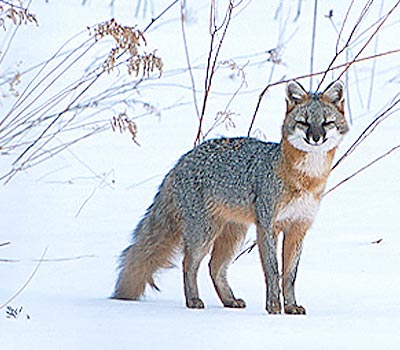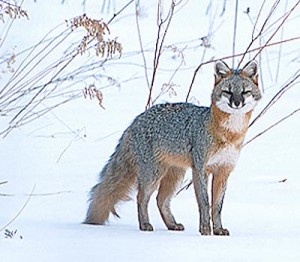In the Open: ODNR Enlists Trapper for gray Fox study

The Ohio Department of Natural Resources’ Division of Wildlife is looking for a few gray foxes, and trappers and hunters can help, even during this upcoming deer gun season.
The division is currently conducting a tracking study on this native species, according to ODNR-DOW conservation worker John Sisson.
The gray fox is one of two fox species in Ohio, the other one being the more-common red fox. They are both members of the same family that of animals that also includes wolves, coyotes, and domestic dogs – Canidae.
A gray fox is typically between eight and 16 pounds in weight, with males being just a little larger than the females, and has a grizzled salt-and-pepper coat. The belly is white with an orange-colored band separating the white belly from the gray sides; the legs and back of the ears are also orange-colored. A black stripe runs along the base of its tail to the tip.
According to the Division of Wildlife, the gray fox was more abundant in Ohio prior to settlement, but settlement and clearing of the land made the habitat more suitable to the red fox.
One of the gray fox’ neatest traits is the ability to climb trees to escape predators or to reach food.
According to bow hunter observations reported to ODNR-DOW, gray fox sightings have decreased from around seven sighting per 1,000 hours in 1990 to less than two sightings per 1,000 hours in 2014. Sisson said that a number of factors including predation from coyotes, disease, and possibly over-trapping during the late 1970s and early 1980s (call it a triple-whammy) could have played a role in the decline.
“All of these things happened around the same time,” he said. “Have they (the gray foxes) recovered? Have we given them enough time to recover?”
The division has a key ally in the Ohio State Trappers Association, which received a blanket permit that allows live removal and relocation of the foxes into holding pens, if needed.
The goal is to trap 20 gray foxes, put radio collars on them, and then monitor them to study their biology and reproductive rates, and OSTA members/trappers are critical to this plan and will be paid $40 for a live, healthy gray fox.
“A trapper can get $10 for a pelt, or cooperate with the study and get $40,” Sisson said, adding that with most of the trappers he’s spoken to, it isn’t about the money.
“They want to save the foxes, they’re very interested in it,” he said.
The count currently stands at two gray foxes, so more foxes are definitely needed, he said. The gray foxes that are trapped are examined for general health and need to be in good condition so they can be collared and released on-site.
If the fox is in poor condition the trapper cannot receive the $40, he said, so the foxes must be healthy and able to be released. Once they are collared, the foxes are released at the site where they were caught, in their own home range.
How can deer hunters help? By reporting gray fox sightings and road kills.
Additionally if you have trail camera photos of gray fox, please share them. Photos can help determine the foxes’ distribution and abundance throughout the state, Sisson said. Locally taken photos of gray foxes, black bears and bobcats (i.e. those that haven’t been forwarded countless times and with a verifiable source and location) can be emailed to [email protected]
Anyone actually trapping a gray fox can call John Sisson, any time day or night, at 740-288-5093, or Suzie Prange at 740-590-3138 to make arrangements for data gathering, collaring and release. Call anytime. Leave a message if you don’t get an answer and your call will be returned ASAP, he said.
In addition, Ohioans are encouraged to help enforce state wildlife laws by reporting violations to the division’s Turn-In-a-Poacher (TIP) hotline by calling 800-POACHER (762-2437). Established in 1982, the TIP program allows individuals to anonymously call toll-free to report wildlife violations.
The 800-POACHER hotline is open for calls 365 days a year, 24 hours a day. Tips concerning wildlife violations can also be submitted at wildohio.gov. Tipsters may be eligible to receive a cash award.
Jim Freeman is the wildlife specialist for the Meigs Soil and Water Conservation District. He can be contacted weekdays at 740-992-4282 or [email protected]









